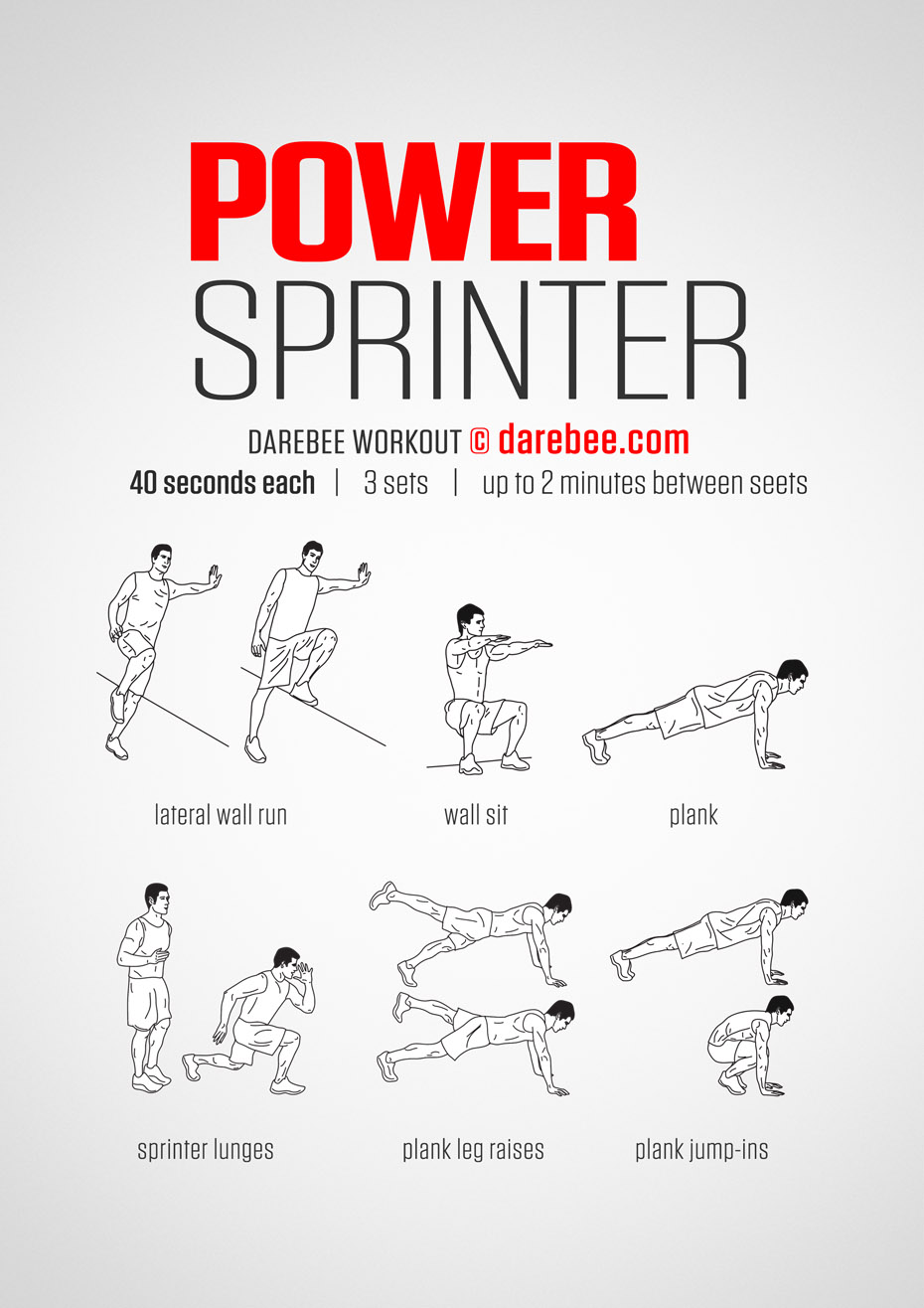
Unleashing the Inner Bolt: Best Exercises for Explosive Strength in Sprinting
Sprinting is a symphony of raw power, precision, and unparalleled speed. At its core, the ability to accelerate from a standstill and maintain top-end velocity hinges significantly on one critical physical attribute: explosive strength. This isn’t just about being strong; it’s about being able to generate maximum force in the shortest possible time. For sprinters, developing this specific quality means the difference between merely running fast and truly flying.
This comprehensive guide delves into the science behind explosive strength for sprinting and outlines the most effective exercises to cultivate this crucial athletic characteristic. We’ll explore various training modalities, from foundational strength to highly specific power drills, ensuring a holistic approach to transforming your sprint performance.
The Science of Sprint Explosiveness: More Than Just Muscle
Before we jump into exercises, it’s essential to understand what makes a sprinter explosive. It’s a complex interplay of neuromuscular factors, not just big muscles.
- Rate of Force Development (RFD): This is the ultimate determinant of explosive strength. It’s how quickly you can generate force, not just how much force you can produce. In sprinting, ground contact time is incredibly brief (often less than 0.1 seconds), meaning sprinters must apply immense force rapidly to propel themselves forward.
- Stretch-Shortening Cycle (SSC): This biomechanical phenomenon is critical. When a muscle is rapidly stretched (eccentric phase), it stores elastic energy, which is then released during the subsequent concentric contraction (shortening phase), leading to a more powerful movement. Think of a coiled spring. Plyometrics heavily rely on optimizing the SSC.
- Triple Extension: The simultaneous and rapid extension of the hip, knee, and ankle joints is the power driver in sprinting. This action, seen in jumping, throwing, and Olympic lifts, is fundamental to generating propulsive force off the ground.
- Neuromuscular Coordination: The brain’s ability to recruit and synchronize motor units efficiently determines how effectively muscles work together to produce powerful, coordinated movements. Training for explosiveness enhances this connection.
Therefore, training for explosive strength isn’t just about lifting heavy; it’s about training the body to produce force quickly and efficiently.
The Pillars of Explosive Strength Training for Sprinters
A well-rounded explosive strength program integrates several training modalities, each targeting different aspects of power production.
1. Plyometrics: Harnessing the Stretch-Shortening Cycle
Plyometrics are exercises that involve rapid and forceful muscular contractions following a rapid stretch. They are quintessential for improving RFD and optimizing the SSC, directly translating to more powerful ground contacts in sprinting.
- Box Jumps:
- Execution: Stand facing a sturdy box. Explode upwards, driving through your hips and arms, landing softly on the box with bent knees. Step down (don’t jump down to reduce impact).
- Benefits: Develops vertical power, improves hip extension, and teaches efficient landing mechanics.
- Variations: Lateral box jumps, single-leg box jumps.
- Broad Jumps (Standing Long Jumps):
- Execution: Stand with feet shoulder-width apart. Swing arms back, bend at the knees and hips, then explode forward, jumping as far as possible. Land softly with bent knees.
- Benefits: Enhances horizontal power, crucial for acceleration and initial drive phase.
- Variations: Single-leg broad jumps.
- Depth Jumps:
- Execution: Step off a low box (start with 12-18 inches). Upon landing, immediately explode into a vertical jump or broad jump. The rapid eccentric phase (landing) preloads the muscles for a more powerful concentric contraction.
- Benefits: Highly effective for improving RFD and reactive strength, but also high impact. Requires good foundational strength.
- Bounds:
- Execution: A series of exaggerated, powerful running strides where the goal is maximum horizontal distance and airtime with each step. Focus on a powerful knee drive and hip extension.
- Benefits: Mimics sprint mechanics, improves elastic strength, and enhances stride length.
- Variations: Single-leg bounds, alternating bounds.
- Hurdle Hops:
- Execution: Place a series of low hurdles (or cones) in a line. Jump over each hurdle consecutively, minimizing ground contact time between hurdles.
- Benefits: Develops reactive strength, improves rhythm, and enhances quick ground contact.
Key Plyometric Considerations:
- Quality over Quantity: Focus on maximal effort and perfect technique for each repetition.
- Recovery: Plyometrics are demanding. Allow adequate rest between sets and sessions.
- Progression: Start with low-impact drills and gradually increase height, distance, or complexity.
- Landing Mechanics: Always land softly with bent knees to absorb impact and prevent injury.
2. Olympic Lifts and Their Variations: Full-Body Power Development
Olympic lifts (Snatch and Clean & Jerk) are arguably the pinnacle of full-body explosive power development. They require strength, speed, flexibility, and coordination, directly addressing the triple extension crucial for sprinting.
- Power Clean:
- Execution: Starting from the floor (or hang position), explosively pull the bar upwards, shrugging the shoulders and rapidly extending the hips, knees, and ankles (triple extension). Catch the bar in a front rack position (shoulders, chest) with a quarter squat.
- Benefits: Develops immense full-body power, especially in the hips, glutes, and hamstrings. Directly trains the triple extension with heavy loads.
- Power Snatch:
- Execution: Similar to the power clean, but the bar is lifted overhead in one continuous motion, caught in an overhead squat position (usually a quarter squat for power snatches).
- Benefits: Even more demanding than the clean, requiring greater speed and coordination. Excellent for overall power and overhead stability.
- Hang Power Clean/Snatch:
- Execution: Starts from a "hang" position (bar above the knees or mid-thigh), eliminating the initial pull from the floor.
- Benefits: Emphasizes the explosive hip drive and triple extension, making it excellent for teaching the second pull of the lift.
- Clean/Snatch Pulls:
- Execution: Perform the first and second pull phases of the clean or snatch without catching the bar. Focus on a powerful shrug and full triple extension.
- Benefits: Allows for heavier loads than the full lifts, strengthening the specific muscle groups involved in the pull phase without the technical complexity of the catch.
Key Olympic Lift Considerations:
- Technique is Paramount: These lifts are highly technical. Seek qualified coaching to learn proper form before increasing load.
- Progressive Overload: Start with very light weights, focusing purely on technique. Gradually increase weight as proficiency improves.
- Lower Reps: Due to their explosive nature, Olympic lifts are typically performed for 1-3 repetitions per set with significant rest.
3. Compound Strength Training: Building the Foundation
While plyometrics and Olympic lifts develop speed-strength, foundational absolute strength is still crucial. Stronger muscles have the potential to generate more force, which can then be trained for speed.
- Back Squats:
- Execution: Barbell on the upper back, descend into a deep squat, keeping a neutral spine, then drive back up.
- Benefits: Develops overall lower body strength, particularly in the quads, glutes, and hamstrings. Essential for increasing the force potential in triple extension.
- Front Squats:
- Execution: Barbell held in a front rack position (across the shoulders), descend into a deep squat.
- Benefits: Places more emphasis on the quads and core, promoting a more upright torso which can translate to better sprint posture.
- Deadlifts (Conventional or Sumo):
- Execution: Lift a barbell from the floor to a standing position, engaging the entire posterior chain (glutes, hamstrings, lower back).
- Benefits: Unparalleled for developing posterior chain strength, which is vital for hip extension and driving off the ground.
- Romanian Deadlifts (RDLs):
- Execution: Similar to deadlifts but focus on a hip hinge, keeping legs relatively straight, lowering the bar to mid-shin while feeling a stretch in the hamstrings.
- Benefits: Excellent for hamstring and glute strength and flexibility, crucial for powerful leg drive and injury prevention.
- Lunges (Barbell or Dumbbell):
- Execution: Step forward (or backward) into a lunge, lowering the back knee towards the ground, then drive back up.
- Benefits: Develops unilateral (single-leg) strength, stability, and balance, which is highly specific to the alternating leg action in sprinting.
Key Compound Strength Considerations:
- Rep Ranges: For strength development, aim for 3-6 repetitions per set. For power emphasis, 1-5 reps at 70-85% of 1RM, performed explosively.
- Progressive Overload: Consistently challenge your muscles by increasing weight, reps, or sets over time.
4. Core Strength and Stability: The Power Transfer Hub
A strong core acts as the central link for power transfer from the lower body to the upper body and vice versa. Without a stable core, energy leaks occur, reducing the efficiency of sprint mechanics.
- Planks (and variations): Front plank, side plank, plank with leg/arm lift.
- Benefits: Builds isometric strength and endurance in the entire core musculature.
- Medicine Ball Throws: Overhead slams, rotational throws, chest passes.
- Benefits: Develops rotational power and explosive core strength, mimicking the arm drive and torso rotation in sprinting.
- Anti-Rotation Exercises: Pallof press.
- Benefits: Trains the core to resist unwanted twisting, promoting stability during dynamic movements.
5. Sprint Drills and Specificity: Translating Power to the Track
Ultimately, all strength and power gains must be translated onto the track. Specific sprint drills help bridge the gap between gym work and actual sprint performance.
- Resisted Sprints:
- Execution: Sprinting while dragging a sled, wearing a resistance band, or running uphill.
- Benefits: Increases force production requirements, strengthens the drive phase, and improves acceleration mechanics.
- Hill Sprints:
- Execution: Sprinting up a steep incline.
- Benefits: Naturally forces a powerful drive, emphasizes knee lift, and reduces top-end speed, making it safer for high-intensity work while still developing power.
- Acceleration Drills: Falling starts, block starts, wall drills.
- Benefits: Refines the initial drive phase, improves reaction time, and teaches efficient body angles for acceleration.
- Max Velocity Drills: Fly sprints (running a measured distance after a long acceleration zone).
- Benefits: Develops the ability to maintain top speed and improves mechanics at high velocities.
Integrating Training: Periodization and Recovery
Simply listing exercises isn’t enough; how you integrate them into a structured program is key.
- Periodization: Divide your training year into cycles (macro, meso, micro) focusing on different qualities at different times. An off-season might prioritize general strength, transitioning to more power and speed-specific work closer to competition.
- Progressive Overload: Continuously challenge your body to adapt by gradually increasing intensity, volume, or complexity.
- Specificity: Ensure a significant portion of your training directly mimics the demands of sprinting.
- Recovery: This is non-negotiable for adaptation and injury prevention. Prioritize sleep (8-10 hours), proper nutrition (adequate protein, carbohydrates, fats), hydration, and active recovery (foam rolling, stretching, light movement).
- Warm-up & Cool-down: Always perform a dynamic warm-up before explosive work and a cool-down with static stretching afterward.
Sample Training Week (Illustrative)
Here’s a highly simplified example of how these elements might be distributed, emphasizing that a personalized program from a qualified coach is always recommended:
- Monday (Power/Plyo Focus): Dynamic warm-up, plyometrics (box jumps, depth jumps), Olympic lift variation (power clean), core work.
- Tuesday (Track/Speed Focus): Dynamic warm-up, acceleration drills, max velocity sprints, light plyos (bounds).
- Wednesday (Active Recovery/Mobility): Foam rolling, stretching, light cardio.
- Thursday (Strength/Power Focus): Dynamic warm-up, compound lifts (squats, RDLs), medicine ball throws, unilateral strength (lunges).
- Friday (Track/Speed Endurance): Dynamic warm-up, resisted sprints, short to medium sprint repeats, core work.
- Saturday/Sunday: Rest or active recovery.
Conclusion
Developing explosive strength for sprinting is a journey that demands dedication, intelligent programming, and a deep understanding of biomechanics. By systematically incorporating plyometrics, Olympic lifts, foundational strength training, robust core work, and specific sprint drills, athletes can unlock their full power potential. Remember that consistency, proper technique, and adequate recovery are the cornerstones of progress. Unleash your inner bolt by committing to this multi-faceted approach, and watch your sprint times drop as you transform into a more powerful, explosive, and unstoppable force on the track.



